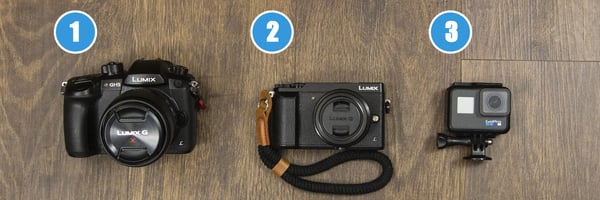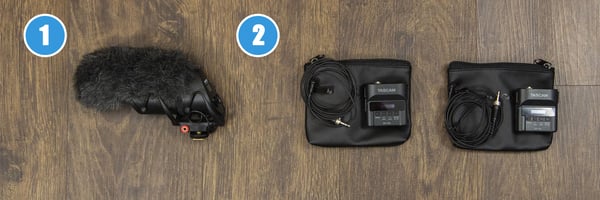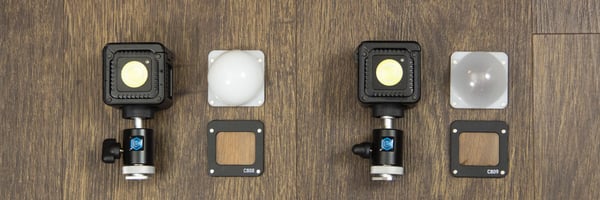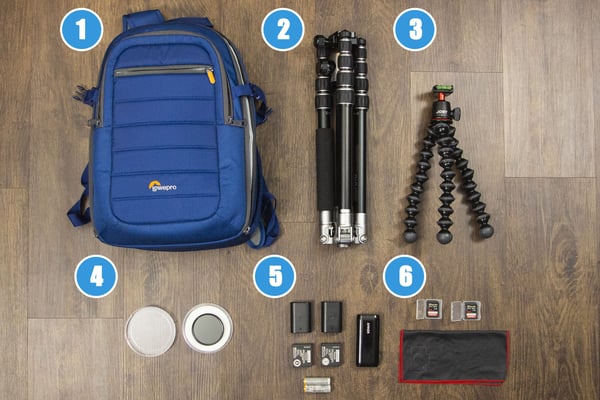.webp?width=200&height=75&name=blue-ridge-heating-air%20(1).webp)






Comfort Media Group has been producing video for HVAC clients since 2013. In that time, we've amassed quite a collection of fancy video production equipment; some of which we use more than others. You can get an idea for what's in our kit here. But, this article is specifically about the equipment we bring along on case study shoots.
Our lower backs are eternally thankful that we don't need everything that's in our kit for every kind of video we want to produce. In the instance of shooting a case study video, hauling things like a green screen or heavy lighting equipment to a job site would be superfluous.
Years of experience shooting case study video has informed how we pack a light, yet versatile video travel kit. The goal here is to pack enough gear to produce high-quality video and be ready for almost anything, while minimizing trips to and from the car.
Sometimes we're lucky enough to have specific information about the job or situation we're about to walk into. In that case, we'll pack our bags accordingly. Otherwise, here is the gear that we pack to be light and prepared enough for most situations:
* The gear listed below is available from multiple brands and vendors. Most of the time, it doesn't make a difference which you use. Whether it be Sony, Nikon, etc., feel free to choose which ever brand you're most comfortable with. The items below are what we've found work best for us.

These days, almost anything you want to accomplish, you can do so with the phone in your pocket. But, if you're looking to create videos that stand out from the rest, it's still recommended that you use more traditional video equipment.
Luckily, high quality video gear has become relatively inexpensive. DSLR and mirrorless cameras can produce incredibly professional looking, almost film-quality, images. What a crazy future we live in!
We recommend bringing along at least two quality cameras. It's handy to have a backup, just in case, and if you end up filming an interview, having two angles to cut between not only looks better, but gives you more to work with in the editing room.
1. Main Camera - Panasonic GH5: When we first embarked on our video adventures, we were slinging Canon DSLRs on video shoots and the 1080p video quality was stunning. We switched because Canon's focus was clearly the photographer, but the Panasonic GH5 was built for video. Being a mirrorless camera, it's a bit more compact and easier to sling about. Plus, features like dual memory card slots, limitless video recording, 4K, etc. make it ideal for almost any video project you have in mind. It's our workhorse and it takes great pictures too.
PANASONIC LUMIX GH5 Body 4K Mirrorless Camera with LUMIX G X VARIO II 12-35mm F2.8 Lens
2. B-camera - Panasonic Gx85: At a fraction of the cost of the GH5, Panasonic's, almost pocket-sized, Gx85 has a lot of the same features as it's bigger bro. We use this as a backup, a second camera if we have an additional camera person, or during two-camera interviews. The fact that it uses the same color profile and similar video quality to the GH5, it makes it a perfect compliment to our workhorse.
PANASONIC LUMIX GX85 4K Digital Camera, 12-32mm and 45-150mm Lens Bundle
3. Wildcard - GoPro HERO6 Black: Of course, we picked up our HERO6 about a week before the HERO7 came out featuring advanced stabilization. Whatever. It's a handy, just-in-case, camera that can do some things that your other cameras can't. They're waterproof and mountable almost everywhere making them fun to be creative with. For case studies, we've used them to set up a time-lapse shots of an installation, mount in a service vehicle, etc.

DSLR and mirrorless cameras are notorious for their below average, on-board microphones. For everyday run-and-gun shooting, you'll need to add a camera mounted condenser or shotgun microphone to your kit.
And, for almost any time you want to record a person talking on camera or during an interview, we recommend using lavalier mics. While sometimes intrusive to your on-screen talent, lavalier microphones are the best way to record a person's voice without also recording any excess background noise, which is perfect for a job site.
These mics tend to be pretty sensitive to wind or the breeze from an AC vent. Don't forget the windscreens.
1. Camera-mounted Mic - Shure Lenshopper VP83F: Most camera-mounted mics work by plugging into the audio input jack of your DSLR or mirrorless camera, tasking the camera to record the audio. The Shure Lenshopper VP83F does this as well, but also has the ability to record to an internal micro SD card. Having the ability to get two recordings at the same time is great peace-of-mind just in case one were to fail. It happens.
Shure VP83F LensHopper Camera-Mount Shotgun Microphone - With Shure A83-FUR Fur Windjammer
2. Lavalier Mics - Tascam DR-10L x2: A couple of things we love about these lav mics is that the microphone screws into the recorder preventing it from being yanked out by mistake and all of the surface buttons lock while recording takes place so that it's not accidentally stopped or paused. This is great because both of those things were problems we encountered with a couple of previous lav systems and it was a total bummer to find out, after the fact, that our recordings we cut short... or worse.
Tascam DR-10L Digital Recorder Headphones & 32GB SD Card (2-Pack)

Often overlooked, the best way to take your video image quality from pedestrian to professional is to add lighting. Filming technicians working at the job site often takes place in basements or attics where good lighting is hard to come by (or set up). Also, in most interview situations, proper lighting can really make your subject pop.
Lume Cubes: Lume Cubes are like the GoPro of video lighting. They're a bit on the pricey side for what they are, but they're, convenient, versatile, and there are a ton of available accessories helping you get as creative as you want. More importantly, they're super-bright! Two of these cubes along with the magnetic warming gels and diffusers that easily attach to the front of the lights are perfect for throwing in our bag for a case study shoot.
Lume Cube - (Two Pack - Black)

This is where we can really get carried away. But, again, in the spirit of traveling light, here is the default accessory line-up that we bring along for almost all of our case study video shoots.
1. Camera Bag: The bag that we use isn't anything special. It fits pretty much everything in our default kit and has padded sections to keep the cameras safe.
2. MeFOTO Roadtrip Travel Tripod/Monopod: While it lacks a traditional fluid head for video (we usually shoot handheld anyway), the MeFOTO travel tripod is light, compact, and can turn into monopod. Just another way to keep our kit flexible.
MeFOTO Classic Aluminum Roadtrip Travel Tripod/Monopod Kit
3. JOBY GorillaPod - A GorillaPod is another item that adds to the versatility of our travel gear. It can be used as a handheld or traditional, albeit short, tripod. You can also use its tentacle like legs to grip onto any number of possible mounting spots.
4. Variable ND Filter: ND filters are basically sunglasses for your camera. Being able to dial back the exposure while shooting in the sun can make for a much nicer image and can help you make sure your picture isn't over exposed. Under exposed video can be fixed in post. Once an image is blown out, there's no getting it back.
Hoya 58mm Variable Density Screw-in Filter
5. Extra Batteries and Power Bank: There's plenty to keep track during a video shoot without having to worry about running out of battery juice. We bring a total of 4 charged batteries each for our Panasonic cameras which is enough to comfortably shoot for around 3 hours; give or take, depending on our usage.
Panasonic DMW-BLF19 Lithium-Ion Battery Pack
Panasonic DMW-BLG10 Lithium-Ion Battery Pack
Anker PowerCore 10000
6. Extra Memory Cards and Lens Cloth: If you're shooting in 1080p you should be using SD cards that are 45mbps or higher and least 95mbps if you're shooting in 4K. And, storage-wise, when shooting in 1080p we tend to use 32GB cards and 64GB when shooting in 4K. Otherwise, get a lens cloth and always keep it on your bag.
SanDisk Extreme Pro SDHC UHS-I Cards
Drones are incredibly impractical. They're expensive, bulky, have a steep learning curve, you can't fly them in a lot of locations, and you'll need to become an FAA certified drone pilot just to be able to use one commercially.
But, by golly, the footage you can get from a consumer drone is mesmerizing! If you're serious about this whole video thing, there's nothing that increases your production value more than adding a drone to your kit.
Admittedly, we don't get to use this thing too much. But, when we do, not only is it a blast to fly, but the footage takes our videos to another level.
DJI Mavic 2 Pro: When it comes to consumer drones, DJI is pretty much the only brand name you need to know.
There are more compact drones available, but the DJI Mavic 2 Pro features top quality video which was most important to us. It also does all sorts of fancy things to capture great looking video like hyperlapse, circle, and waypoint modes.
DJI Mavic 2 Pro Drone
DJI Mavic 2 Fly More Kit for Mavic 2 Pro

About the Dan Kelly:
.webp?width=200&height=75&name=blue-ridge-heating-air%20(1).webp)





